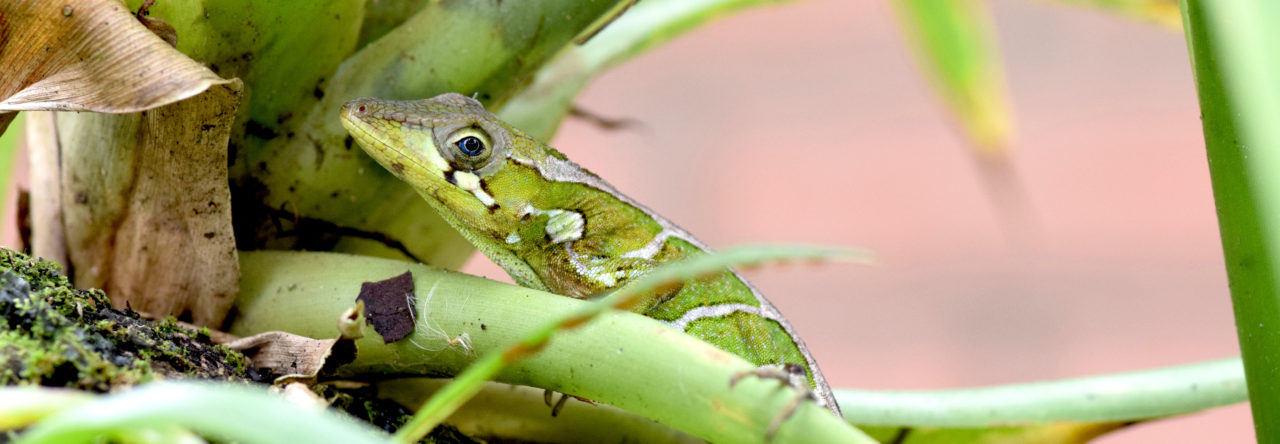
The Puerto Rican Racer, Alsophis portoricensis. Photo by Donald Gudehus
Sometimes it’s easy to forget that anoles aren’t the only animals in the Caribbean. But, in fact, there are other types, even of reptiles, and some of them have diversified a fair bit (though none, of course, to the extent of anoles). One such group are the alsophiine snakes, formerly all in the genus Alsophis. This Caribbean radiation of racer-like snakes includes at least 43 species ranging in size from 200-2000 mm in length and occupying a variety of habitats.
 Recently, Frank Burbrink and colleagues, in a paper in the Journal of Biogeography, have re-analyzed DNA data originally presented by Hedges et al. and have investigated rates of species, morphological and ecological diversification. The phylogenetic tree they recover is very similar to the Hedges et al. phylogeny and indicates fairly extensive within-island diversification. Sounds very anole-like, but it turns out that rate of diversification is quite different. Unlike anoles, species diversification and the evolution of morphological variety putter along a fairly constant rate (with a few statistical twists and turns).
Recently, Frank Burbrink and colleagues, in a paper in the Journal of Biogeography, have re-analyzed DNA data originally presented by Hedges et al. and have investigated rates of species, morphological and ecological diversification. The phylogenetic tree they recover is very similar to the Hedges et al. phylogeny and indicates fairly extensive within-island diversification. Sounds very anole-like, but it turns out that rate of diversification is quite different. Unlike anoles, species diversification and the evolution of morphological variety putter along a fairly constant rate (with a few statistical twists and turns).
Why the difference? Burbrink et al. postulate that the opportunity for diversification has been just as great for alsophiines as for anoles, so why are the evolutionary patterns different? The authors put forward a number of possible explanations, but none is compelling. Of course, although adaptive radiations often exhibit explosive bursts of diversification, there is no necessity for this to occur, and some very diverse groups have radiated at a more sedate pace. Moreover, one might question why alsophiines haven’t diversified even more–sure, they differ in body size and climatic niche, but how different are they otherwise? And how many species can co-occur at a given locality? Is it just lack of time–one of Burbrink et al.’s hypotheses–or is something constraining alsophiine diversification?
More generally, it would be interesting to conduct similar analyses on other Caribbean taxa–not just reptiles, but also amphibians, birds, even insects and plants–to see what generalities, if any, characterize Caribbean evolutionary diversification.
- Evolution in Real Time on Lizard Island - March 23, 2025
- Spider Snags Adult Anolis osa - March 22, 2025
- An Homage to the Green Anoles of New Orleans - March 21, 2025


Skip (James) Lazell
Don’t you think anoles just speciate more often and more rapidly? Their complex reproductive behavior (courtship, territoriality, etc.) lead to rapid local adaptation and shorter isolation times for reproductive isolation. Snakes are slower evolvers, seems to me…. Still, in the Antilles a pretty impressive array, and ecotypic adaptation too. Skip
Armando Pou
I’m not sure if they are from the same Genus, but racers are notorious Anolis eaters here in south Florida; maybe they have spread throughout the Caribbean in a predator – prey coupling. In southern Florida the southern black racer (Coluber constrictor priapus) is one of the few snake species (other than ringnecks) that has actually flourished in urban and suburban environments, largely due to exotic lizards and frogs. The Brahminy blind snake which is exotic has also become quite common.
James Stroud
I can attest to this, I have seen Southern black racers eating brown anoles and also snooping menacingly in and out of a large red-head agama colony